Cuisine
This article includes a list of general references, but it lacks sufficient corresponding inline citations. (August 2023) |
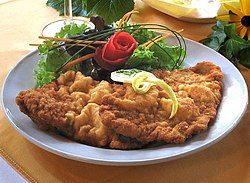
A cuisine is a style of
Etymology
Used in English since the late 18th century, the word cuisine—meaning manner or style of cooking—is borrowed from the French for "style of cooking", as originally derived from Latin coquere "to cook".[2]
Influences on cuisine
A cuisine is partly determined by ingredients that are available locally or through trade. Regional ingredients are developed and commonly contribute to a regional or national cuisine, such as Japanese rice in Japanese cuisine.
Some factors that have an influence on a region's cuisine include the area's
The area's climate, in large measure, determines the native foods that are available. In addition, climate influences food preservation. For example, foods preserved for winter consumption by smoking, curing, and pickling have remained significant in world cuisines for their altered gustatory properties.
The trade among different countries also largely affects a region's cuisine. Dating back to the ancient spice trade, seasonings such as
Certain foods and food preparations are required or proscribed by the religiousness or sumptuary laws, such as Islamic dietary laws and Jewish dietary laws.
Culinary culture exchange is also an important factor for cuisine in many regions: Japan's first substantial and direct exposure to the West came with the arrival of European missionaries in the second half of the 16th century. At that time, the combination of Spanish and Portuguese game frying techniques with an East Asian method for cooking vegetables in oil, led to the development of tempura, the "popular Japanese dish in which seafood and many different types of vegetables are coated with batter and deep fried".[7]
History
Cuisine dates back to Antiquity. As food began to require more planning, there was an emergence of meals that situated around culture.[8]
Evolution of cuisine
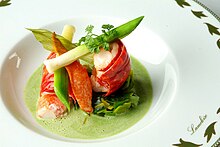
Cuisines evolve continually, and new cuisines are created by innovation and cultural interaction. One recent example is
Global cuisine
A global cuisine is a cuisine that is practiced around the world, and can be categorized according to the common use of major foodstuffs, including grains, produce and cooking fats.
Regional diversity
African cuisine

African cuisines use a combination of locally available fruits, cereals and vegetables, as well as milk and meat products. In some parts of the continent, the traditional diet features a preponderance of milk, curd and whey products. In much of tropical Africa, however, cow's milk is rare and cannot be produced locally (owing to various diseases that affect livestock). The continent's diverse demographic makeup is reflected in the many different eating and drinking habits, dishes, and preparation techniques of its manifold populations.[15]
-
Typical Ethiopian and Eritrean cuisine: Injera (thin pancake-like bread) and several kinds of wat (stew)
-
fish. Chicken yassa is pictured.
Asian cuisines

Due to Asia's vast size and extremely diverse geography and demographics,
-
Due toGuangdong's location on the southern coast of China, fresh live seafood is a specialty in Cantonese cuisine. Such markets selling seafood are found across East Asia.
-
TraditionalNorth Indian vegetarian thali with various curries from India. Various curry dishes are found across South Asia.
-
A market stall at Thanin market in Chiang Mai, Thailand, selling readily-made food. Market stalls selling food are found across Southeast Asia.
-
A Tajik feast. A large feast is commonly associated with cultures of Central Asia.
European cuisine
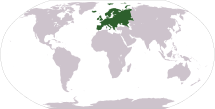
-
Traditional pizza from Napoli: originally Italian dish
-
Beef Stroganoff, a Russian dish.
Oceanian cuisine

-
Bush Tucker (bush foods) harvested at Alice Springs Desert Park in Australia
-
A Hāngī being prepared, a New Zealand Māori method of cooking food for special occasions using hot rocks buried in a pit oven.
Cuisines of the Americas

The
-
A Jamaican patty wrapped in coco bread.
-
Buffalo wings with blue cheese dressing, served with lager beer.
See also
| Food | Drink | Wine |
| Beer | Liquor | Coffee |
- Culinary art
- Diet food
- Dish (food)
- Food group
- Food photography
- Food preparation
- Food presentation
- Foodpairing
- Haute cuisine
- Kitchen
- List of cuisines
- List of foods
- List of nutrition guides
- Meal
- Outline of cuisines
- Outline of food preparation
- Portion size
- Recipe
- Restaurant
- Traditional food
- Whole food
References
- ^ "Rediscover the flavors and traditions of true American cuisine!" Whatscookingamerica.net. Accessed June 2011.
- ^ "Cuisine". Online Etymology Dictionary. 2023. Retrieved 3 April 2023.
- ISBN 9781350008472.
- ISBN 9781420094961.
- ISBN 9781315414645.
- ^ "spice trade". Encyclopædia Britannica. Retrieved 23 April 2016.
- ^ "Japanese Food Culture" (PDF). Web Japan. 18 December 2008. p. 2. Archived (PDF) from the original on 31 March 2010. Retrieved 18 June 2019.
- ISBN 978-0-520-26645-2.
- ^ Lindsey, Robert (18 August 1985). "California Grows Her Own Cuisine". The New York Times.
- ISSN 1609-9168.
- ^ "Why is Molecular Gastronomy?". www.scienceofcooking.com. Retrieved 23 April 2016.
- ISSN 0261-3077. Retrieved 23 April 2016.
- ^ "Sichuan Cuisine". www.chinadaily.com.cn. Retrieved 23 April 2016.
- ^ "The American Food Revolutions: Cuisines in America." Eldrbarry.net. Accessed June 2011.
- ISBN 0-8065-1398-5. Archived from the originalon 16 December 2008. Retrieved 18 December 2008.
- ^ "The flavors of Asia". Quaker Oats Company. Archived from the original on 4 June 2007. Retrieved 19 December 2008.
- ^ "Cuisine Areas Of Asia". Kraft Foods (Australia). 2007. Archived from the original on 25 February 2011. Retrieved 20 December 2008.
- ^ Leung Man-tao (12 February 2007), "Eating and Cultural Stereotypes", Eat and Travel Weekly, no. 312, p. 76. Hong Kong
- ISBN 978-0-313-08790-5.
Further reading
- Albala, Ken (2011). Food Cultures of the World Encyclopedia Greenwood. ISBN 978-0-313-37626-9
- California Culinary Academy (2001). In the World Kitchen: Global Cuisine from California Culinary Academy. Bay Books (CA). ISBN 1-57959-506-5.
- Laudan, Rachel (2013). Cuisine and Empire: Cooking in World History University of California Press. ISBN 978-0-520-26645-2
- MacVeigh, Jeremy (2008). International Cuisine. Delmar Cengage Learning; 1st edition. ISBN 1-4180-4965-4.
- Nenes, Michael F; Robbins, Joe (2008). International Cuisine. Hoboken, N.J.: Wiley, John & Sons; 1st edition. ISBN 0-470-05240-6.
- Scarparto, Rosario (2000). New global cuisine: the perspective of postmodern gastronomy studies. Royal Melbourne Institute of Technology.
- Zobel, Myron (1962). Global cuisine: being the unique recipes of the 84 top restaurants of the world. Patron Press.
External links
 Eating and drinking travel guide from Wikivoyage
Eating and drinking travel guide from Wikivoyage- The Elizabeth Robins Pennell Collection at the Library of Congress has many volumes on the topic of cuisine.






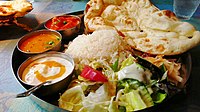

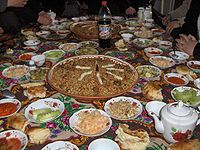









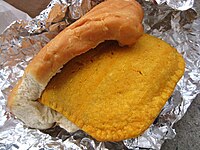

![Tacos filled with several meat types, mainly beef, chicken and pork.[19]](http://upload.wikimedia.org/wikipedia/commons/thumb/7/73/001_Tacos_de_carnitas%2C_carne_asada_y_al_pastor.jpg/200px-001_Tacos_de_carnitas%2C_carne_asada_y_al_pastor.jpg)





